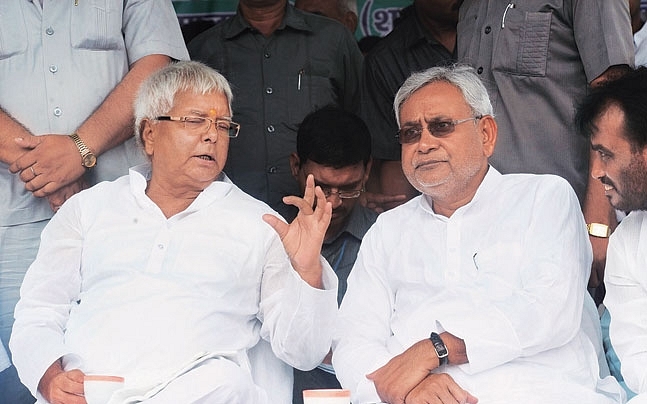Politics
Nitish Kumar’s Wrong Turn In 2013 Has Left Him And His Party Powerless Before Lalu Yadav
- Nitish Kumar’s best course of action, even now, is to rebuild ties with the BJP, rework the coalition in Bihar, and focus on taking that state to new heights.
- He will be senior partner in this alliance and master of his own destiny as pre-eminent leader in a big state.

Lalu Prasad Yadav and Nitish Kumar
The recent Republic TV expose, which shows Bihar mafia don and jailbird Mohammed Shahabuddin, complaining to his party chief Lalu Prasad Yadav about a superintendent of police, is unlikely to make waves beyond a point. The nexus between criminals and politicians is old hat in Bihar, but what the disclosure underlines is Chief Minister Nitish Kumar’s captive status in his state. His room to manoeuvre is limited, and his image as a clean and non-compromising politician has taken a beating. Reason: despite evidence that a thug is talking to Lalu Yadav from jail, he will be shown as impotent to act against criminals. If he does act, his hold on power will be tenuous.
Kumar made a Faustian bargain to remain in power in 2014, when his party was trounced by the Bharatiya Janata Party (BJP) in the Lok Sabha elections. To retain moral authority after a defeat, he first put Jitan Ram Manjhi in his seat, and when he felt it was time to take back his gaddhi, he used Lalu Yadav to get this done. Unfortunately for him, the Mahagathbandhan between his Janata Dal United, Lalu Yadav’s Rashtriya Janata Dal, and the Congress, which brought him back to power in 2015, ensured his diminution when Lalu Yadav won more seats than him.
While Lalu Yadav did not claim the chief minister’s chair after winning more seats, this was less due to his generosity than a shrewd calculation that Nitish Kumar serves as Chief Minister at his pleasure. It became an arrangement like Manmohan Singh and Sonia Gandhi, where the former was PM, but individual ministers were not accountable to Singh. Just as Singh could do nothing about the 2G and coal scams, Kumar can do little about recalcitrant dons or Lalu Yadav’s ministers – unless Lalu deigns to back him. Lalu Yadav’s RJD ministers run their ministries on their own, and take few orders from Kumar.
It is also entirely possible that in the event of a hung parliament in 2019, Lalu Yadav will push forward Kumar’s candidacy for the Prime Ministership, leaving his son Tejashvi (now Deputy CM) as Chief Minister of Bihar – a deal in which his family will then control all the levers of power in Bihar, as well as have significant clout in Delhi.
The problem is Nitish Kumar is a much diminished politician today, as he stays in power only at Lalu Yadav’s convenience. Pride will not easily allow him to seek the BJP’s support to recreate the winning JD(U)-BJP combination of 2010. Having broken that alliance in 2013 over the nomination of Narendra Modi as the BJP’s prime ministerial candidate, Kumar will find it tough to cosy up again to a party where Modi is now more powerful than ever. Even if he were to swallow his pride and seek a deal with the BJP, he will lose his credibility with the Muslim vote bank, which will then possibly swing more decisively to Lalu Yadav’s RJD in the short term. The JD(U) will become a pale shadow of itself.
In effect, Nitish Kumar has diminished both himself and his party due to visions of becoming Prime Minister when it seemed as if 2014 would result in a hung parliament.
He was too clever by half, and is now paying the price.
His best course of action, even now, is to rebuild ties with the BJP, rework the coalition in Bihar, and focus on taking that state to new heights. He will be senior partner in this alliance, and master of his own destiny as pre-eminent leader in a big state.
In a tieup with Lalu Yadav, he will remain a weak CM, and all the allegations against Lalu will stick to him. Even if he does make it to prime ministership in the event of hung parliament, he will not last long. He could check with Deve Gowda. Multi-party coalitions allow you to become PM only if you are willing to kowtow to every regional party boss, and you get turfed out if you get any ideas about building your own power base.
Coalitions headed by small parties have not worked in India.
Introducing ElectionsHQ + 50 Ground Reports Project
The 2024 elections might seem easy to guess, but there are some important questions that shouldn't be missed.
Do freebies still sway voters? Do people prioritise infrastructure when voting? How will Punjab vote?
The answers to these questions provide great insights into where we, as a country, are headed in the years to come.
Swarajya is starting a project with an aim to do 50 solid ground stories and a smart commentary service on WhatsApp, a one-of-a-kind. We'd love your support during this election season.
Click below to contribute.
Latest